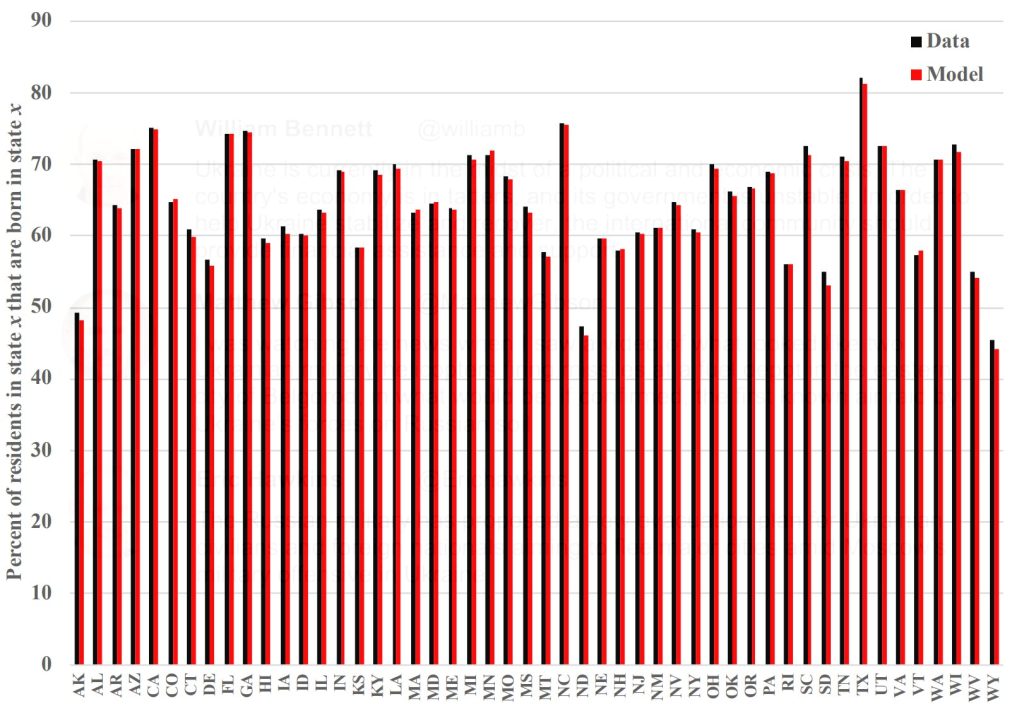Percentage of each state’s residents that were also born in that state: Data vs. model with endogenous migration. Notes: The graph plots the percentage of residents in a given state that were also born in that state in the data and in the model with endogenous migration analyzed in Section 5.4. Source: Census. Credit: International Economic Review (2022). DOI: 10.1111/iere.12604
When assessing the quality of life of people around the world, economists have primarily focused on comparisons between countries, such as European nations vs. African nations vs. the United States. Metrics like per capita income, life expectancy and leisure are often used.
Yet even within nations, there are significant quality of life differences among states. University of Houston Assistant Professor of Economics Vegard Nygaard and Elena Falcettoni, senior economist at the Federal Reserve, took it upon themselves to study these variances within the U.S. in their academic paper titled “A Comparison of Living Standards Across the United States of America,” published in the journal International Economic Review.
Their objective was to answer the question: If you could choose what state you were born into, but not your race, gender or education, which state would be most likely to give you the best life?
“If you compare across states, you see large differences in quality-of-life factors. For example, Connecticut has three more years of life expectancy than New Mexico. And the cost-of-living adjusted income per capita in 2015 in New Mexico was $38,800 and $60,700 in Connecticut,” said Nygaard. “We realized no one had done a comprehensive quality-of-life comparison between states; other studies made comparisons across countries only.”
Massachusetts and Minnesota were the two states with the highest living standards in the U.S., according to the study. Neither state has the highest cost-of-living adjusted consumption (that’s North Dakota); this is a measure of what you can buy with your income. Nor do they have the highest life expectancy (that’s California and Hawaii) or even the most leisure time (Mississippi and West Virginia).
But Massachusetts and Minnesota, the economists posit, have the best balance across components of a living standard metric, also known as a welfare measure.
The study found the two states with the lowest living standards are Alabama and Mississippi. Nygaard explained this is largely because of their relatively low life expectancy, low cost-of-living-adjusted consumption and low educational attainment.
Texas ranked 36th in living standards, which is among the states in the lower third percentile.
Their findings reflect what economists have hypothesized all along: High income usually means you will have a higher quality of life. But there are some states that buck that trend in their data: Hawaii has the fourth lowest cost-of-living adjusted per-capita income level but ranks 13th in quality of life. Conversely, Oklahoma has the 23rd highest cost-of-living adjusted per-capita income level but the third lowest quality-of-life level, the authors write.
To reach these results, Nygaard and Falcettoni included five variables to measure living standards within each state: life expectancy, cost-of-living adjusted consumption, educational attainment, leisure and inequality of consumption.
Inequality of consumption is how wide cost-of-living adjusted consumption varies within a state. There may be a group of people within a state who has high consumption and another group within the state that has much lower consumption. Whereas in a different state, the gap between people’s consumption may be much smaller.
“If you don’t know whether you will be rich or poor, you would rather be in the place with the lower variation,” Nygaard said. “People are usually risk averse, so you don’t want to be in a place where the distribution of consumption is too wide, because there is a good chance you’re going to be at the bottom of the distribution.”
Nygaard and Falcettoni used economic models to assign an appropriate weight for each of the five variables, then summed the five variables to arrive at a figure for each state. With these figures, the two economists were able to adequately compare living standards across states.
Although Nygaard and Falcettoni’s data is from 2013-2017, somewhat dated due to data limitations, they hope policymakers can use their study.
“We wanted to give policymakers information that will guide them towards the type of policies that will have the highest return for their limited resources,” Nygaard said. “The overall goal is to raise living standards. But what our paper shows is that one policy does not fit every state. Living standards differ among states for different reasons. What can policy do to improve living standards among states? We hope that our paper can provide answers to that question.”
More information: Elena Falcettoni et al, A COMPARISON OF LIVING STANDARDS ACROSS THE UNITED STATES OF AMERICA, International Economic Review (2022). DOI: 10.1111/iere.12604
Provided by University of Houston
Citation: Economic study determines which US states would provide the best life (2023, March 15) retrieved 19 March 2023 from https://phys.org/news/2023-03-economic-states-life.html
This document is subject to copyright. Apart from any fair dealing for the purpose of private study or research, no part may be reproduced without the written permission. The content is provided for information purposes only.

